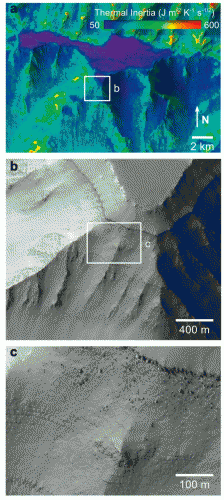Mars is widely understood to be a volcanic planet — its surface shows abundant evidence of volcanic activity, both ancient and more recent. Spacecraft detect lava flows in many locations, and spectroscopic evidence of volcanic rocks lies almost everywhere.

SOFT SLOPES. The walls of Coprates Chasma in Valles Marineris are impressive, but slopes are modest (10° to 30°). Moreover, the weathering shows the wall materials are loosely consolidated and lacking the rocky cliffs that extensive lava flows would produce. Thermal inertia values (top frame) indicate weak cohesion, characteristic of material blown out of explosive volcanic eruptions. (Image taken from Figure 1 in the paper.)
The authors of a new paper in Icarus, led by Joshua Bandfield (University of Washington), argue that Mars’ style of volcanism was different in its early days, and that the early Martian crust was probably not built up from countless lava flows. Such a view has been suggested before, but the new work shows much evidence supporting it.
“A prevalent view of the upper Martian crust is that it is dominantly composed of lava flows that may have been subsequently disrupted by the creation of a mega-regolith through impact events,” the team writes. If this were true, they say, these crustal materials would have the physical properties found in highly fractured but competent blocks like those derived from lava flows or well-cemented sandstones.
The problem is, they don’t. Says Bandfield, “If Mars was made up of lava flows, we’d see piles and piles of rocks strewn all over the place — instead, we see lots of stuff with the consistency of dirt clods.” The place to look for competent blocky or solid materials, the team says, is in younger, less cratered regions.
The researchers used image-maps of thermal inertia to distinguish loosely consolidated materials from harder, more competent ones. Thermal inertia measures the resistance of materials to changes in temperature. High thermal inertia materials are tougher and more solid such as large blocks and outcrops of rock. Low thermal inertia surfaces, on the other hand, typically have loose and less cohesive materials such gravel, sand, and those that crumble easily as they weather.
The areas the scientists studied include Valles Marineris, Ares and Kasei Valles, and several large craters, particularly in the southern highlands. The team reports that, “the stratigraphy of the upper several kilometers of the Valles Marineris system dominantly displays repetitive bedding where more resistant layers are separated by tens of layers of less resistant, thinner layers.”
The more resistant layers, they note, display a rough texture at meter (yard) scales and produce boulders. The blocks, however, evidently break up after they roll only a few hundred meters downslope, suggesting they are also composed of weak materials.
Comparing Mars with Earth, the researchers say, “Where high strength rocks are present in arid, vegetation-free environments on Earth, they are associated with steep slopes such as canyon walls and commonly have talus slopes that form at the base and persist for extended periods of time.”
These features, they observe, appear only in isolated locations within older Martian terrain. They should be much more pervasive if high-strength blocky materials (such as lava flows and floods) dominated earlier times.
More evidence appears in the valley networks carved by outflows, say the scientists. The extensive erosion these networks imply would require less water and smaller floods if the surface materials were generally loose and less cohesive.
Similarly, most meteorites of Martian origin have younger dates. Potential meteorites from Mars’ early days were less likely to survive being ejected if they were made of weaker materials.
Explosive volcanism commonly occurs when molten magma meets groundwater (or ground ice), which flashes into steam. The results are steam-powered explosions and a lot of meltwater. In this light, the scientists say, the transition to effusive eruptions may have followed the general drying out of the planet’s mantle or its permafrost-rich upper crust — or both.
If that happened, Bandfield notes, it could connect with some other events in the Martian past. For example, he says, “the possible drying out of the mantle can be linked to less vigorous mantle convection, which can then be linked to less core convection and the shutting off of the Martian magnetic field. Abundant crustal water in early times might also have led to the formation of phyllosilicates [clays] during the same time period.”









Pingback: Astrogeo Netzschau: Besinnliche Vulkane und anthropogenes Meersalz › AstroGeo › SciLogs - Wissenschaftsblogs